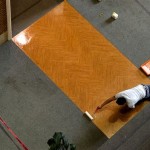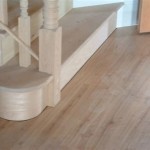Labor Cost to Install Laminate Flooring on Stairs Per Square Foot
Installing laminate flooring on stairs can enhance the aesthetics and durability of a home. However, determining the labor cost associated with this project requires a careful consideration of several factors. The cost is often calculated per square foot, but the complexity of the staircase, the type of laminate being installed, and the local labor market all play a significant role in the final price. This article will delve into the various elements that influence the labor cost of installing laminate flooring on stairs, providing a comprehensive overview for homeowners considering this home improvement project.
Before diving into the specific cost breakdowns, it's important to understand the general scope of work involved in installing laminate flooring on stairs. This typically includes removing any existing flooring (carpet, tile, or other materials), preparing the subfloor, measuring and cutting the laminate planks to fit each stair, and securely attaching the laminate using adhesives and/or fasteners. The process also includes installing stair nosing, which is a crucial safety feature that provides a finished edge and prevents slipping. Each of these steps contributes to the overall labor time and, consequently, the cost.
Key Factors Influencing Labor Cost
Several factors contribute to the labor cost when installing laminate flooring on stairs. A thorough understanding of these factors is essential for accurately estimating the total expense of the project.
Complexity of the Staircase: The design and structure of the staircase significantly impact the labor time required. Straight stairs are generally the easiest and least expensive to work on. Curved or winding stairs, on the other hand, present a more complex challenge, demanding more precise cuts and fitting, which increases labor costs. The presence of features like banisters, railings, and unusual angles also adds to the complexity and time needed for installation. Open-back stairs, where there is no riser, also pose a different challenge compared to closed-back stairs.
Type of Laminate Flooring: The type of laminate flooring chosen for the stairs also influences the labor cost. Thicker laminate planks, especially those with attached underlayment, can be slightly more cumbersome to cut and install, potentially adding to the labor time. Some laminate products are specifically designed for stair installation and may come with specialized components like stair treads and risers, which can streamline the installation process and potentially reduce labor costs. However, these specialized products may also be more expensive to purchase. The quality of the laminate planks also affects the ease of installation. High-quality laminate generally cuts cleaner and fits together more precisely, leading to a more efficient installation process.
Preparation of the Subfloor: The condition of the existing staircase and its subfloor is a critical factor affecting labor costs. If the subfloor is uneven, damaged, or requires significant repairs, the labor cost will increase. Preparing the subfloor might involve leveling the surface, filling cracks or holes, and ensuring it is clean and dry before installing the laminate. In situations where the existing stairs are severely damaged or structurally unsound, it may be necessary to reinforce or rebuild them, which will significantly increase the overall project cost. This preparation ensures that the laminate flooring is installed on a stable and even surface, preventing future issues like unevenness, squeaking, or premature wear.
Typical Labor Costs Per Square Foot
The labor cost to install laminate flooring on stairs is typically calculated on a per-square-foot basis, but it's important to note that this is just an estimate. The actual cost can vary based on the factors mentioned earlier. As a general guideline, the labor cost can range from $4 to $12 per square foot. Lower-end costs are usually associated with straightforward staircase designs and relatively simple laminate installations, while higher-end costs reflect more complex staircase designs, difficult laminate materials, and extensive subfloor preparation. It's imperative to obtain multiple quotes from qualified flooring contractors to get a more accurate estimate for a specific project.
The square footage calculation for a staircase is typically based on the surface area of the treads (the horizontal part of the stair) and the risers (the vertical part of the stair). For a standard staircase with a consistent tread depth and riser height, calculating the total square footage is relatively straightforward. However, for staircases with varying dimensions or curved designs, a more precise measurement is necessary. Contractors typically factor in waste when estimating the amount of laminate and any additional materials required for the job. This waste allowance is essential to account for cuts and mistakes during the installation process.
In addition to the per-square-foot labor cost, there may be other associated expenses to consider. These can include the cost of removing and disposing of existing flooring, the cost of materials such as stair nosing, adhesives, and fasteners, and any additional charges for travel or project management. It's important to get a detailed breakdown of all costs from the contractor to avoid any surprises later on.
Additional Cost Considerations
Beyond the base labor cost, several additional factors can influence the total expense of installing laminate flooring on stairs. These factors often relate to the quality of materials used, the scope of the project, and regional cost variations.
Material Costs: The type and quality of laminate flooring chosen directly impact the overall project cost. Higher-quality laminate options tend to be more durable, water-resistant, and aesthetically pleasing, but they also come with a higher price tag. Similarly, the cost of stair nosing can vary depending on the material (wood, metal, or laminate) and design. The type of adhesive and fasteners used also contributes to the material costs. It's important to balance cost considerations with the desired quality and durability of the finished product. Investing in higher-quality materials can often result in a longer lifespan and reduced maintenance costs over time.
Geographic Location: Labor costs can vary significantly depending on the geographic location. Areas with a higher cost of living typically have higher labor rates. The availability of qualified flooring contractors in a particular region can also influence pricing. In areas with a limited number of contractors, demand may drive up labor costs. Researching average labor rates in the local area and obtaining multiple quotes from different contractors is a good way to gauge the prevailing market prices.
Removal and Disposal of Existing Flooring: The process of removing and disposing of existing flooring can add to the overall project cost. This task can be time-consuming and labor-intensive, especially if the existing flooring is difficult to remove or requires specialized tools. Some contractors include the cost of removal and disposal in their labor estimate, while others charge it as a separate expense. Confirming whether removal and disposal are included in the quote is essential to avoid any unexpected costs later on.
Obtaining Accurate Quotes and Project Planning
To ensure an accurate understanding of the labor cost to install laminate flooring on stairs, careful planning and communication with potential contractors are essential. Obtaining multiple quotes and asking the right questions can help homeowners make informed decisions and avoid potential pitfalls.
Getting Multiple Quotes: It is always recommended to obtain quotes from at least three different flooring contractors. This allows for a comparison of pricing, scope of work, and estimated timelines. When requesting quotes, provide contractors with as much detail as possible about the project, including the dimensions of the staircase, the type of laminate flooring being considered, and any specific challenges or concerns. A detailed description of the project will help contractors provide more accurate and competitive quotes.
Checking Contractor Credentials: Before hiring a contractor, it's crucial to verify their credentials and ensure they are licensed and insured. A licensed contractor has met certain professional standards and is accountable for their work. Insurance protects homeowners from liability in case of accidents or damages during the installation process. Checking references from previous clients is also a good way to assess the contractor's reputation and quality of work.
Verifying Project Scope and Timeline: A clear understanding of the project scope and timeline is essential for managing expectations and avoiding misunderstandings. Before starting the project, ensure that the contract clearly outlines all aspects of the work, including the specific tasks to be performed, the materials to be used, the estimated start and completion dates, and the payment schedule. Regularly communicating with the contractor throughout the project is helpful in addressing any questions or concerns that may arise and ensuring that the project stays on track.

What S The Cost Of Installing Laminate Flooring In 2025 Checkatrade

The Cost To Install Laminate Flooring In 2025 Nerdwallet

What S The Cost Of Installing Laminate Flooring In 2025 Checkatrade

How Much Does Flooring Installation Cost 2025 Guide

A Complete Guide For Cost To Lay Laminate Flooring

How Much Does It Cost To Install A Vinyl Plank On Stairs Lx Hausys

How Much Does Laminate Flooring Installation Cost Angi

Laminate Flooring Installation Cost Estimator Estimate Florida Consulting

How To Install Laminate Flooring On Stairs Atkinson Inspection Services

How To Install Laminate Flooring On Stairs Atkinson Inspection Services
Related Posts








